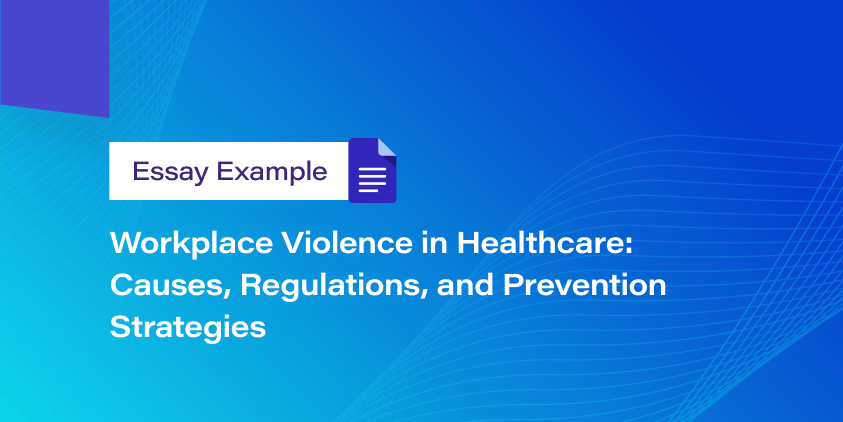Workplace Violence in Healthcare: Causes, Regulations, and Prevention Strategies

Workplace violence between patients and caregivers is a fundamental challenge in society. For example, healthcare providers often interact with unstable patients who could be under the influence of drugs, are gang members, or have a history of violence. Such aggressive patients might inflict physical and psychological harm to caregivers through threats, verbal abuse, harassment, and hostility. As a result, nurses are subjected to unnecessary stress, trauma, and injuries that impair their duties and responsibilities in a healthcare environment. According to the Bureau of Labor Statistics, workplace violence in hospitals is more common than in other industry sectors, which raises the need for intervention. Analyzing political, legal, and legislative factors that influence workplace violence and preventive measures and protocols in hospital settings would be essential in solving this serious problem.
The Political, Legal, and Legislative Factors that Influence Violence in Healthcare Setting
Various risk factors facilitate violence in health care. Patients are the main initiators of workplace violence in a healthcare environment; however, political, legal, and legislative factors also contribute to the problem. Thus, political factors include the understaffing of nurses, which implies that the government has failed to employ adequate personnel to deal with the increasing population and reduced the number of older nurses who retire. As a result, the ratio of healthcare providers is low, which reduces efficiency in caring for patients who often become agitated, resulting in violence. Another political factor is inadequate healthcare resources, whereby the government fails to distribute adequate resources for healthcare. As such, such a situation fosters poor quality of care and patients’ negative attitudes toward healthcare providers. The insufficient allocation of funds is another political factor influencing healthcare violence. The government does not provide enough funds for hospitals to invest in security.
At the same time, the legal and legislative factors that foster violence in the healthcare environment consist of the Affordable Care Act, which has enabled wide access to healthcare services via government-subsidized insurance coverage. As a result, healthcare centers have been overwhelmed, which leads to long waiting hours and often causes patient dissatisfaction and workplace violence. Another legislative factor is the lack of signs in the hospitals, warning against workplace violence. Thus, patients, who could be under the influence of drugs, perceive violence as normal in healthcare. The lack of clear legislation to prevent and report workplace violence is another legal factor that encourages the problem, which causes most violent encounters between patients and care providers to go unreported. Thus, it is clear that various political, legal, and legislative factors influence workplace violence in healthcare.
Evaluation of OSHA Regulations and the ANA Position Statement on Workplace Violence to Organization Policies
The Occupation Safety and Health Association (OSHA) is committed to eradicating workplace violence. According to Papa and Venella, the OSHA regulations on workplace violence presuppose management commitment, employee participation, worksite analysis, hazard prevention and control, safety and health training, recordkeeping, and program evaluation. Thus, management commitment and employee participation regulations direct the organization’s managers and frontline employees to work together to promote the safety of health workers and their patients. The worksite analysis regulation prompts organization policies to assess a workplace for potential hazards that could cause violence by conducting a screening survey and analyzing the hospital’s security. Hazard prevention and control imply an organization’s policies that aim to design mitigation and control measures for hazards identified through the worksite analysis. The safety and health training regulation guides organizations to raise awareness among the staff about the workplace hazards present and teach them how to protect themselves. Lastly, recordkeeping and program evaluation enable an organization to evaluate the success and effectiveness of the programs established for sustainable, safe working conditions.
The American Nurses Association (ANA) is similarly committed to ending workplace violence in healthcare. The organization affirms that nurses are committed to helping others; however, they should also be treated with respect and dignity in the workplace. As Saltzberg and Clark claim, the ANA’s position statement on workplace violence in organizations’ policies includes zero tolerance towards this phenomenon among healthcare providers. Hence, physical and emotional abuse are no longer accepted as a part of nurses’ jobs. The statement also delineates that nurses and the management should work together to create a culture of respect and safety. Lastly, the position statement supports the development of evidence-based strategies to mitigate workplace violence. Therefore, both organizations encourage healthcare providers to combat workplace violence through proper regulations.
Safety Policies and Protocols for Preventing and Responding to Violence Against Healthcare Workers
Safety policies and protocols are necessary to prevent and respond to workplace violence against healthcare providers. Therefore, collaboration and commitment of healthcare workers and managers in eradicating workplace violence ensure that the problem is resolved across different settings, from the emergency department to patient discharge procedures. Working together also makes worksite analysis efficient, as all risk factors that foster workplace violence, including free hospital movement and the possession of weapons in the healthcare setting, will be addressed. Such safety policies and protocols make it easy for managers to develop preventive strategies, including intensifying security staff and training them to identify violence and take appropriate action. Safety and health training of caregivers is also essential since it raises awareness of the appropriate actions to take when facing workplace violence.
Conclusion
Workplace violence between patients and caregivers has been outlined as a serious problem in society since it inflicts physical and psychological harm to the latter, thereby deterring their quality of care and performance. The political and legal factors that facilitate workplace violence in healthcare settings are the understaffing of nurses, inadequate healthcare resources, the poor allocation of funds, the Patient Protection and Affordable Care Act, lack of warning legislation signs in hospitals against workplace violence, and the absence of clear legislation for violence prevention and incident reporting. Nonetheless, OSHA regulations and the ANA position statement have been developed to address the problem of workplace violence in healthcare. They encourage healthcare providers to work together with the management to address and prevent the discussed issue from happening.
📎 References
1. Blando, J., Ridenour, M., Hartley, D., & Casteel, C. (2015). Barriers to effective implementation of programs to prevent workplace violence in hospitals. Online Journal of Issues in Nursing, 20(1), 1–11. https://doi.org/10.3912/OJIN.Vol20No01PPT01
2. Bureau of Labor Statistics. (2016, April 25). Hospital workers suffered 294,000 nonfatal workplace injuries and illnesses in 2014. Retrieved from https://www.bls.gov/opub/ted/2016/hospital-workers-suffered-294000-nonfatal-workplace-injuries-and-illnesses-in-2014.htm
3. Papa, A., & Venella, J. (2013). Workplace violence in healthcare: Strategies for advocacy. Online Journal of Issues in Nursing, 18(1), Manuscript 5. https://doi.org/10.3912/OJIN.Vol18No01Man05
4. Saltzberg, C. W., & Clark, C. M. (2015). A bold call to action: Mobilizing nurses and employers to prevent and address incivility, bullying, and workplace violence. American Nurse Today, 10(8). Retrieved from https://www.myamericannurse.com/bold-call-action-mobilizing-nurses-employers-prevent-address-incivility-bullying-workplace-violence/
5. Speegle-Clark, K. (2013). Violence in the workplace: A prevention program for healthcare workers. Retrieved from ProQuest Dissertations and Theses database.

